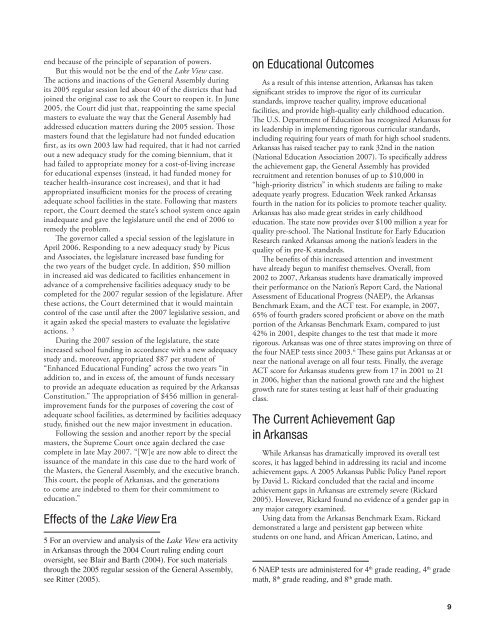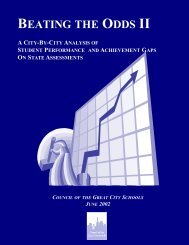WHAT IS ARKANSAS DOING TO CLOSE THE ACHIEVEMENT GAP?
WHAT IS ARKANSAS DOING TO CLOSE THE ACHIEVEMENT GAP?
WHAT IS ARKANSAS DOING TO CLOSE THE ACHIEVEMENT GAP?
You also want an ePaper? Increase the reach of your titles
YUMPU automatically turns print PDFs into web optimized ePapers that Google loves.
end because of the principle of separation of powers.<br />
But this would not be the end of the Lake View case.<br />
The actions and inactions of the General Assembly during<br />
its 2005 regular session led about 40 of the districts that had<br />
joined the original case to ask the Court to reopen it. In June<br />
2005, the Court did just that, reappointing the same special<br />
masters to evaluate the way that the General Assembly had<br />
addressed education matters during the 2005 session. Those<br />
masters found that the legislature had not funded education<br />
first, as its own 2003 law had required, that it had not carried<br />
out a new adequacy study for the coming biennium, that it<br />
had failed to appropriate money for a cost-of-living increase<br />
for educational expenses (instead, it had funded money for<br />
teacher health-insurance cost increases), and that it had<br />
appropriated insufficient monies for the process of creating<br />
adequate school facilities in the state. Following that masters<br />
report, the Court deemed the state’s school system once again<br />
inadequate and gave the legislature until the end of 2006 to<br />
remedy the problem.<br />
The governor called a special session of the legislature in<br />
April 2006. Responding to a new adequacy study by Picus<br />
and Associates, the legislature increased base funding for<br />
the two years of the budget cycle. In addition, $50 million<br />
in increased aid was dedicated to facilities enhancement in<br />
advance of a comprehensive facilities adequacy study to be<br />
completed for the 2007 regular session of the legislature. After<br />
these actions, the Court determined that it would maintain<br />
control of the case until after the 2007 legislative session, and<br />
it again asked the special masters to evaluate the legislative<br />
actions. 4 5<br />
During the 2007 session of the legislature, the state<br />
increased school funding in accordance with a new adequacy<br />
study and, moreover, appropriated $87 per student of<br />
“Enhanced Educational Funding” across the two years “in<br />
addition to, and in excess of, the amount of funds necessary<br />
to provide an adequate education as required by the Arkansas<br />
Constitution.” The appropriation of $456 million in generalimprovement<br />
funds for the purposes of covering the cost of<br />
adequate school facilities, as determined by facilities adequacy<br />
study, finished out the new major investment in education.<br />
Following the session and another report by the special<br />
masters, the Supreme Court once again declared the case<br />
complete in late May 2007. “[W]e are now able to direct the<br />
issuance of the mandate in this case due to the hard work of<br />
the Masters, the General Assembly, and the executive branch.<br />
This court, the people of Arkansas, and the generations<br />
to come are indebted to them for their commitment to<br />
education.”<br />
Effects of the Lake View Era<br />
5 For an overview and analysis of the Lake View era activity<br />
in Arkansas through the 2004 Court ruling ending court<br />
oversight, see Blair and Barth (2004). For such materials<br />
through the 2005 regular session of the General Assembly,<br />
see Ritter (2005).<br />
on Educational Outcomes<br />
As a result of this intense attention, Arkansas has taken<br />
significant strides to improve the rigor of its curricular<br />
standards, improve teacher quality, improve educational<br />
facilities, and provide high-quality early childhood education.<br />
The U.S. Department of Education has recognized Arkansas for<br />
its leadership in implementing rigorous curricular standards,<br />
including requiring four years of math for high school students.<br />
Arkansas has raised teacher pay to rank 32nd in the nation<br />
(National Education Association 2007). To specifically address<br />
the achievement gap, the General Assembly has provided<br />
recruitment and retention bonuses of up to $10,000 in<br />
“high-priority districts” in which students are failing to make<br />
adequate yearly progress. Education Week ranked Arkansas<br />
fourth in the nation for its policies to promote teacher quality.<br />
Arkansas has also made great strides in early childhood<br />
education. The state now provides over $100 million a year for<br />
quality pre-school. The National Institute for Early Education<br />
Research ranked Arkansas among the nation’s leaders in the<br />
quality of its pre-K standards.<br />
The benefits of this increased attention and investment<br />
have already begun to manifest themselves. Overall, from<br />
2002 to 2007, Arkansas students have dramatically improved<br />
their performance on the Nation’s Report Card, the National<br />
Assessment of Educational Progress (NAEP), the Arkansas<br />
Benchmark Exam, and the ACT test. For example, in 2007,<br />
65% of fourth graders scored proficient or above on the math<br />
portion of the Arkansas Benchmark Exam, compared to just<br />
42% in 2001, despite changes to the test that made it more<br />
rigorous. Arkansas was one of three states improving on three of<br />
the four NAEP tests since 2003. 56 These gains put Arkansas at or<br />
near the national average on all four tests. Finally, the average<br />
ACT score for Arkansas students grew from 17 in 2001 to 21<br />
in 2006, higher than the national growth rate and the highest<br />
growth rate for states testing at least half of their graduating<br />
class.<br />
The Current Achievement Gap<br />
in Arkansas<br />
While Arkansas has dramatically improved its overall test<br />
scores, it has lagged behind in addressing its racial and income<br />
achievement gaps. A 2005 Arkansas Public Policy Panel report<br />
by David L. Rickard concluded that the racial and income<br />
achievement gaps in Arkansas are extremely severe (Rickard<br />
2005). However, Rickard found no evidence of a gender gap in<br />
any major category examined.<br />
Using data from the Arkansas Benchmark Exam, Rickard<br />
demonstrated a large and persistent gap between white<br />
students on one hand, and African American, Latino, and<br />
6 NAEP tests are administered for 4 th grade reading, 4 th grade<br />
math, 8 th grade reading, and 8 th grade math.<br />
9






